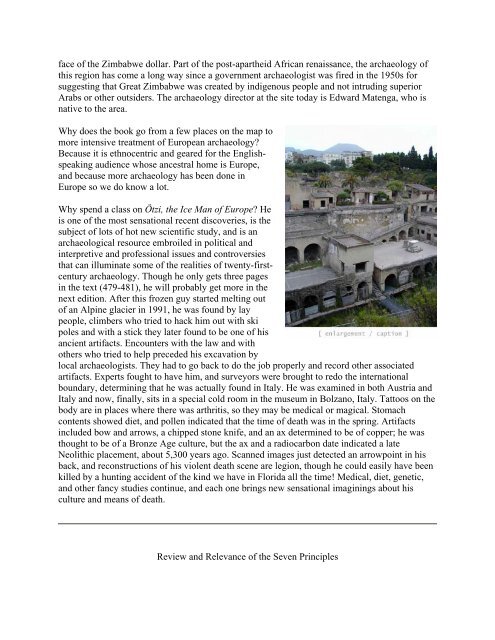INTRODUCTION TO ARCHAEOLOGY Nancy White - Touro Institute
INTRODUCTION TO ARCHAEOLOGY Nancy White - Touro Institute
INTRODUCTION TO ARCHAEOLOGY Nancy White - Touro Institute
Create successful ePaper yourself
Turn your PDF publications into a flip-book with our unique Google optimized e-Paper software.
face of the Zimbabwe dollar. Part of the post-apartheid African renaissance, the archaeology of<br />
this region has come a long way since a government archaeologist was fired in the 1950s for<br />
suggesting that Great Zimbabwe was created by indigenous people and not intruding superior<br />
Arabs or other outsiders. The archaeology director at the site today is Edward Matenga, who is<br />
native to the area.<br />
Why does the book go from a few places on the map to<br />
more intensive treatment of European archaeology?<br />
Because it is ethnocentric and geared for the English-<br />
Europe,<br />
speaking audience whose ancestral home is<br />
and because more archaeology has been done in<br />
Europe so we do know a lot.<br />
Why spend a class on Ötzi, the Ice Man of Europe? He<br />
is one of the most sensational recent discoveries, is the<br />
subject of lots of hot new scientific study, and is an<br />
archaeological resource embroiled in political and<br />
interpretive and professional issues and controversies<br />
that can illuminate some of the realities of twenty-firstcentury<br />
archaeology. Though he only gets three pages<br />
in the text (479-481), he will probably get more in the<br />
next edition. After this frozen guy started melting out<br />
of an Alpine glacier in 1991, he was found by lay<br />
people, climbers who tried to hack him out with ski<br />
poles and with a stick they later found to be one of his<br />
ancient artifacts. Encounters with the law and with<br />
others who tried to help preceded his excavation by<br />
local archaeologists. They had to go back to do the job properly and record other associated<br />
artifacts. Experts fought to have him, and surveyors were brought to redo the international<br />
boundary, determining that he was actually found in Italy. He was examined in both Austria and<br />
Italy and now, finally, sits in a special cold room in the museum in Bolzano, Italy. Tattoos on the<br />
body are in places where there was arthritis, so they may be medical or magical. Stomach<br />
contents showed diet, and pollen indicated that the time of death was in the spring. Artifacts<br />
included bow and arrows, a chipped stone knife, and an ax determined to be of copper; he was<br />
thought to be of a Bronze Age culture, but the ax and a radiocarbon date indicated a late<br />
Neolithic placement, about 5,300 years ago. Scanned images just detected an arrowpoint in his<br />
back, and reconstructions of his violent death scene are legion, though he could easily have been<br />
killed by a hunting accident of the kind we have in Florida all the time! Medical, diet, genetic,<br />
and other fancy studies continue, and each one brings new sensational imaginings about his<br />
culture and means of death.<br />
Review and Relevance of the Seven Principles
















